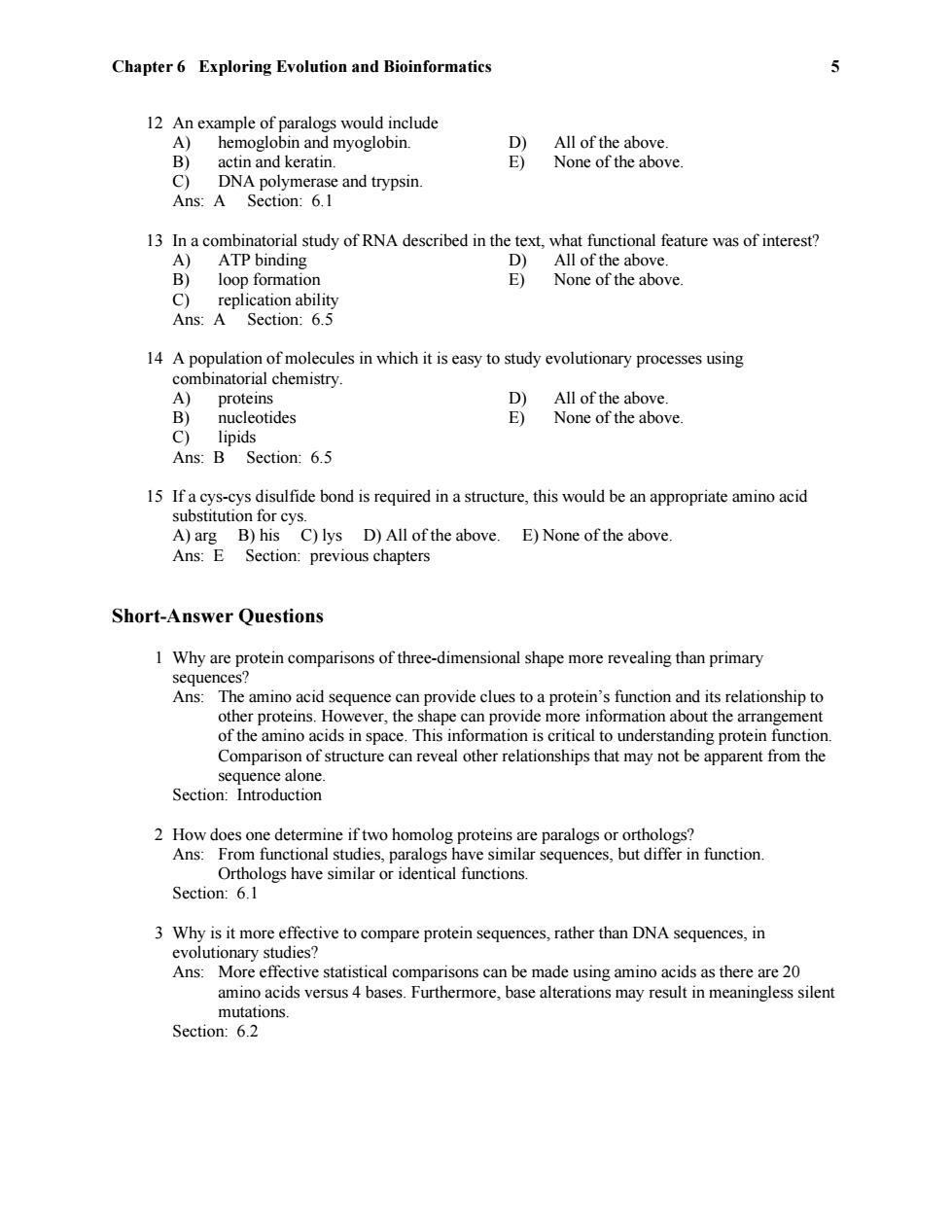正在加载图片...

Chapter 6 Exploring Evolution and Bioinformatics 12 An example of paralogs would include A) hemoglobin and myoglobin. D) All of the above. B) actin and keratin. E) None of the above. c) DNA polymerase and trypsin. Ans:A Section:6.1 13 In a combinatorial study of RNA described in the text,what functional feature was of interest? A) ATP binding D) All of the above. B) loop formation E) None of the above. C)replication ability Ans:A Section:6.5 14 A population of molecules in which it is easy to study evolutionary processes using combinatorial chemistry. A)proteins D) All of the above. B) nucleotides E) None of the above. C)lipids Ans:B Section:6.5 15 If a cys-cys disulfide bond is required in a structure,this would be an appropriate amino acid substitution for cys. A)arg B)his C)lys D)All of the above. E)None of the above Ans:E Section:previous chapters Short-Answer Questions 1 Why are protein comparisons of three-dimensional shape more revealing than primary sequences? Ans:The amino acid sequence can provide clues to a protein's function and its relationship to other proteins.However,the shape can provide more information about the arrangement of the amino acids in space.This information is critical to understanding protein function Comparison of structure can reveal other relationships that may not be apparent from the sequence alone. Section:Introduction 2 How does one determine if two homolog proteins are paralogs or orthologs? Ans:From functional studies,paralogs have similar sequences,but differ in function. Orthologs have similar or identical functions. Section:6.1 3 Why is it more effective to compare protein sequences,rather than DNA sequences,in evolutionary studies? Ans:More effective statistical comparisons can be made using amino acids as there are 20 amino acids versus 4 bases.Furthermore,base alterations may result in meaningless silent mutations. Section:6.2Chapter 6 Exploring Evolution and Bioinformatics 5 12 An example of paralogs would include A) hemoglobin and myoglobin. D) All of the above. B) actin and keratin. E) None of the above. C) DNA polymerase and trypsin. Ans: A Section: 6.1 13 In a combinatorial study of RNA described in the text, what functional feature was of interest? A) ATP binding D) All of the above. B) loop formation E) None of the above. C) replication ability Ans: A Section: 6.5 14 A population of molecules in which it is easy to study evolutionary processes using combinatorial chemistry. A) proteins D) All of the above. B) nucleotides E) None of the above. C) lipids Ans: B Section: 6.5 15 If a cys-cys disulfide bond is required in a structure, this would be an appropriate amino acid substitution for cys. A) arg B) his C) lys D) All of the above. E) None of the above. Ans: E Section: previous chapters Short-Answer Questions 1 Why are protein comparisons of three-dimensional shape more revealing than primary sequences? Ans: The amino acid sequence can provide clues to a protein’s function and its relationship to other proteins. However, the shape can provide more information about the arrangement of the amino acids in space. This information is critical to understanding protein function. Comparison of structure can reveal other relationships that may not be apparent from the sequence alone. Section: Introduction 2 How does one determine if two homolog proteins are paralogs or orthologs? Ans: From functional studies, paralogs have similar sequences, but differ in function. Orthologs have similar or identical functions. Section: 6.1 3 Why is it more effective to compare protein sequences, rather than DNA sequences, in evolutionary studies? Ans: More effective statistical comparisons can be made using amino acids as there are 20 amino acids versus 4 bases. Furthermore, base alterations may result in meaningless silent mutations. Section: 6.2